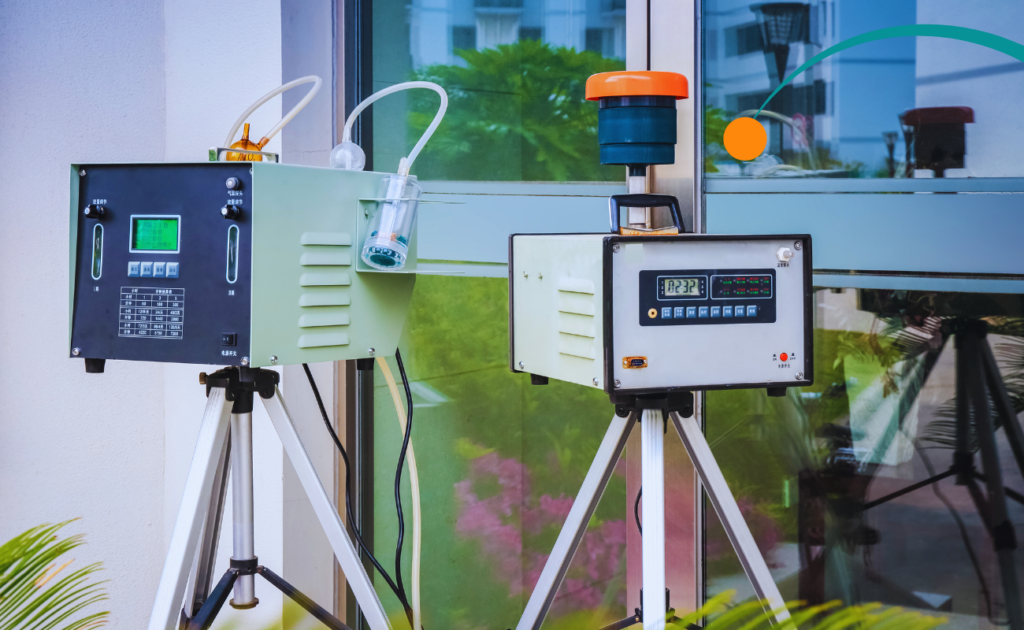Indonesia berada pada persimpangan yang kritis, berjuang dengan masalah AQI yang merupakan salah satu yang paling parah di dunia. Di banyak kota yang ramai di dalamnya, Indeks Kualitas Udara (AQI) secara rutin mencatat tingkat yang menjadi alasan untuk kekhawatiran, menandakan kebutuhan mendesak untuk pemantauan kualitas udara yang efektif.
Blog ini menyelam dalam kejenuhan Indonesia dengan polusi udara, mengekspos pelaku tersembunyi dan menjelajahi bagaimana kemajuan dalam pemantauan kualitas udara dapat memainkan peran penting dalam membalikkan keadaan.
Ketika kami mengungkap kompleksitas tantangan lingkungan ini, jelas bahwa memahami dan meningkatkan AQI bukan hanya masalah kebijakan – itu adalah kebutuhan mendesak untuk kesehatan dan kesejahteraan jutaan orang.
Apa itu AQI?
AQI, atau Indeks Kualitas Udara, adalah denyut nadi kesehatan lingkungan kita, sebuah pengukur penting yang menunjukkan kebersihan udara. Indeks ini adalah alat penting sebagai kompas untuk menavigasi dunia polutan udara yang seringkali tidak terlihat.
Ini menerjemahkan data kualitas udara yang kompleks ke dalam format yang sederhana dan mudah dipahami, menawarkan gambaran tentang seberapa tercemarnya udara dan dampak kesehatannya yang potensial. Secara signifikan, AQI bukan hanya sekadar angka; itu adalah indikator kritis yang memberi peringatan kepada kita tentang polutan berbahaya seperti partikulat, ozon, sulfur dioksida, dan nitrogen dioksida.
Memahami AQI seperti memiliki indera keenam tentang kesehatan lingkungan, memberi kami kekuatan untuk membuat keputusan tentang aktivitas harian kita, terutama di daerah-daerah di mana polusi udara menimbulkan risiko kesehatan yang signifikan.
Peran teknologi dalam pemantauan kualitas udara
Teknologi muncul sebagai harapan dalam menyelesaikan masalah tekanan AQI yang mendesak. Bagian dari blog kami ini mengeksplorasi solusi teknologi inovatif yang merubah cara kami memantau dan memahami kualitas udara.
Dari sensor canggih yang mendeteksi polutan kecil hingga analisis data yang canggih yang memprediksi tren masa depan, teknologi sedang merevolusi pendekatan kami terhadap manajemen kualitas udara. Ini bukan hanya tentang mengumpulkan data; ini tentang membuka wawasan yang mengarah pada langkah-langkah yang dapat diambil, mengubah angka-angka menjadi peta jalan untuk udara yang lebih bersih dan sehat.
Peralatan pemantauan kualitas udara canggih
Lanskap pemantauan kualitas udara berkembang dengan cepat, berkat peralatan canggih yang menawarkan akurasi dan efisiensi yang belum pernah terjadi sebelumnya. Alat modern seperti yang ditawarkan oleh HAS Environmental, termasuk sistem pemantauan kualitas udara yang canggih dan analisis gas, berada di garis depan revolusi ini.
Instrumen-instrumen ini dapat mendeteksi polutan dalam konsentrasi yang rendah, menyediakan data real-time yang kritis untuk penilaian AQI yang akurat. Menggunakan teknologi canggih seperti ini memiliki banyak manfaat. Tidak hanya mereka memberikan data yang lebih dapat diandalkan dan tepat waktu, tetapi mereka juga memungkinkan pendekatan yang lebih proaktif dalam manajemen kualitas udara.
Peralatan canggih ini sangat penting untuk merumuskan kebijakan lingkungan yang efektif dan peringatan kesehatan, yang pada akhirnya meningkatkan kualitas udara dan hasil kesehatan masyarakat. Untuk informasi lebih lanjut tentang alat pemantauan kualitas udara canggih ini, klik di sini.

Bagaimana teknologi membantu meningkatkan kualitas udara
Teknologi telah terbukti menjadi sekutu yang kuat dalam meningkatkan kualitas udara. Mari kita telusuri beberapa studi kasus dan inisiatif yang kuat di mana teknologi telah memainkan peran penting dalam memantau dan meningkatkan kualitas udara.
Salah satu contoh inspiratif adalah implementasi jaringan sensor kota di daerah perkotaan utama. Jaringan ini menggunakan sistem pemantauan kualitas udara canggih untuk menyediakan data real-time tentang tingkat polusi. Informasi ini telah menjadi kritis bagi perencana kota dan pembuat kebijakan untuk mengembangkan strategi yang ditargetkan untuk mengurangi polusi, seperti menerapkan pembatasan lalu lintas atau mempromosikan solusi transportasi bersih.
Pembangunan yang signifikan lainnya adalah penggunaan citra satelit dan teknologi penginderaan jauh. Ini telah memungkinkan pelacakan tren polusi skala besar dan mengidentifikasi titik panas global. Teknologi semacam ini telah menjadi instrumen penting dalam mengatasi masalah polusi udara lintas batas secara internasional.
Selain itu, integrasi kecerdasan buatan dan pembelajaran mesin ke dalam pemantauan kualitas udara telah mengarah pada analisis prediktif menjadi permainan baru. Teknologi-teknologi ini dapat memprediksi tingkat polusi, memungkinkan tindakan preventif untuk melindungi kesehatan masyarakat.
Kemajuan yang signifikan sedang dilakukan melalui intervensi teknologi ini untuk melindungi kesehatan lingkungan dan memastikan masa depan yang berkelanjutan.
Dampak polusi udara terhadap kesehatan masyarakat dan lingkungan di Indonesia
Polusi udara, ancaman yang senyap namun meresap, secara mendalam memengaruhi kesehatan masyarakat dan lingkungan, terutama di Indonesia, di mana bacaan AQI seringkali memberi cerita yang mengkhawatirkan. Bagian dari blog kami ini menyoroti efek-efek berbagai dari kualitas udara yang buruk dan melukiskan gambaran hidup tentang bagaimana bacaan AQI tinggi di Indonesia tidak hanya angka tetapi indikator dari krisis kesehatan dan lingkungan yang lebih dalam.
Dari penyakit-penyakit pernapasan hingga ketidakseimbangan ekologi, kita akan menjelajahi bagaimana polusi udara lebih dari sekadar ketidaknyamanan – itu adalah tantangan kritis yang menuntut perhatian dan tindakan segera untuk kesejahteraan baik orang-orang maupun planet ini.
Risiko kesehatan yang terkait dengan kualitas udara buruk
Tingkat polusi tinggi, seperti yang ditunjukkan oleh bacaan AQI buruk, adalah isyarat dari beberapa risiko kesehatan. Menghirup udara yang tercemar tidak hanya menyebabkan ketidaknyamanan – itu bisa memicu rangkaian masalah kesehatan.
Paparan kronis terhadap polutan dapat menyebabkan masalah pernapasan seperti asma dan bronkitis dan memperburuk kondisi paru-paru dan jantung yang sudah ada. Bukan hanya paru-paru yang terpengaruh; polusi udara telah terkait dengan masalah kesehatan yang lebih luas, termasuk penyakit kardiovaskular dan bahkan gangguan saraf.
Risiko-risiko kesehatan ini menggarisbawahi pentingnya memantau dan meningkatkan kualitas udara, menjadikan AQI sebagai indikator lingkungan dan metrik kesehatan publik yang penting.
Konsekuensi lingkungan dari polusi udara
Konsekuensi lingkungan dari polusi udara sangat dalam dan merata, terutama untuk ekosistem dan keanekaragaman hayati yang kaya di Indonesia. Tingkat AQI yang buruk, yang menunjukkan tingkat polusi yang tinggi, dapat menghancurkan habitat alami. Polutan udara dapat mengubah komposisi tanah dan badan air, mempengaruhi kehidupan tumbuhan dan, pada gilirannya, seluruh rantai makanan.
Gangguan ini menimbulkan ancaman besar bagi spesies-spesies yang beragam di Indonesia, beberapa di antaranya unik untuk hutan hujan dan lingkungan lautnya. Selain itu, polusi dapat berkontribusi terhadap perubahan iklim, memperburuk ekstrem cuaca dan lebih lanjut mengancam ekosistem. Efek domino ini pada lingkungan menyoroti kebutuhan kritis akan pemantauan yang teliti dan peningkatan kualitas udara di Indonesia.
Tanggapan pemerintah dan kebijakan terhadap masalah kualitas udara di Indonesia
Tanggapan pemerintah Indonesia terhadap masalah kualitas udara, terutama tingkat AQI, kompleks dan bervariasi. Bagian dari blog ini membahas secara mendalam tentang bagaimana otoritas Indonesia menangani tantangan polusi udara.
Kita akan menjelajahi kebijakan dan inisiatif yang diimplementasikan untuk mengurangi dampak kesehatan, lingkungan, dan ekonomi dari kualitas udara yang buruk. Memahami tindakan pemerintah ini memberikan wawasan tentang komitmen negara ini untuk meningkatkan AQI dan melindungi kesejahteraan warga dan habitat alami.
Regulasi dan kebijakan untuk manajemen kualitas udara
Pendekatan Indonesia untuk mengelola kualitas udara, terutama AQI, diatur oleh beberapa regulasi dan kebijakan. Inisiatif-inisiatif ini menangani akar penyebab polusi udara dan menerapkan langkah-langkah untuk meningkatkan kualitas udara.
Mereka termasuk regulasi ketat tentang emisi industri, pedoman kontrol polusi kendaraan, dan kebijakan yang mempromosikan sumber energi terbarukan. Selain itu, pemerintah telah memulai program-program untuk meningkatkan kesadaran publik tentang efek polusi udara dan pentingnya perlindungan lingkungan. Upaya-upaya gabungan ini bertujuan untuk secara sistematis mengatasi tantangan polusi udara dan secara bertahap meningkatkan AQI di seluruh negeri.

Kebutuhan akan penegakan yang lebih gencar dan kesadaran publik
Mengisi kesenjangan antara kebijakan dan praktik dalam manajemen kualitas udara adalah krusial untuk meningkatkan AQI di Indonesia. Meskipun pemerintah telah menetapkan kebijakan untuk melawan polusi udara, penegakan yang gencar sering kali diperlukan.
Kesenjangan ini menyoroti perlunya penegakan yang lebih gencar dari regulasi yang ada untuk membuat perbedaan nyata dalam kualitas udara. Selain itu, pendidikan dan kesadaran publik memainkan peran kritis. Ini bukan hanya tentang tindakan pemerintah; warga harus diberi informasi tentang dampak kesehatan dan lingkungan dari kualitas udara yang buruk.
Memberdayakan publik dengan pengetahuan tentang AQI dan efeknya dapat mendorong inisiatif yang dipimpin oleh masyarakat dan memupuk budaya tanggung jawab lingkungan. Pendekatan ganda ini dari penegakan kebijakan yang ketat dan peningkatan kesadaran publik sangat penting untuk kemajuan yang berarti dalam manajemen kualitas udara.
Kesimpulan
Saat kami mengakhiri eksplorasi kami tentang “Kualitas Udara Buruk: Kebutuhan akan Pemantauan Kualitas Udara di Indonesia,” jelas bahwa perjuangan melawan polusi udara sama-sama mendesak dan kompleks.
Dari memahami Indeks Kualitas Udara (AQI) yang kritis hingga meneliti peran teknologi dan kebijakan pemerintah, perjalanan kami telah menyoroti langkah-langkah penting yang diperlukan untuk melawan tantangan lingkungan ini.
Risiko kesehatan dan dampak ekologis menegaskan urgensi tindakan. Blog ini menekankan pentingnya menggabungkan teknologi, penegakan kebijakan, dan kesadaran publik untuk mencapai peningkatan kualitas udara yang nyata. Pada akhirnya, meningkatkan AQI Indonesia bukan hanya tujuan lingkungan, tetapi komitmen untuk kesehatan dan masa depan warganya dan planet ini.





